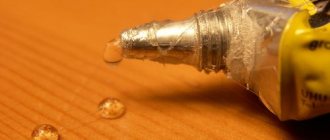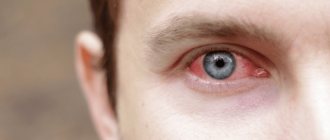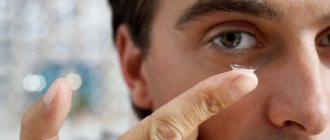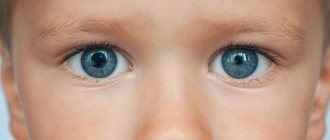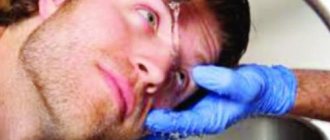Household injuries account for the majority of all traumatic eye injuries. One of the common situations is when an aerosol containing alcohol is accidentally sprayed into the eye. What problems can eye contact with this substance cause? How to act in case of an alcohol burn? Find out about this from the article.
Alcohol is present in many liquids found in the home. It is found in medicines, household chemicals, cosmetics, and alcoholic beverages. If you handle any of these objects carelessly, there is a risk of getting a chemical burn. Alcohol negatively affects the delicate tissues of the eyeball. It destroys both outer membranes and intracellular structures. The negative effects of alcohol can persist long after injury, which is often accompanied by delayed consequences, including blindness. To minimize this risk, you need to know about emergency measures for alcohol burns.
What to do if your eyes are burned with alcohol?
What to do if your eyes are burned with alcohol? This question is asked by people who have been exposed to a chemically active substance. Eye damage from alcohol can occur if the liquid is handled carelessly. A patient who is faced with such a problem should be given immediate medical attention and sent to a medical facility for further treatment as soon as possible.
What medications are used to treat burn injuries to the eye with an alcohol solution?
After emergency assistance is provided, the victim is taken to the hospital. There he is washed with saline solutions, after which the ophthalmologist draws up a scheme for further therapy. As a rule, treatment of eye burns with alcohol is carried out using medications in the form of drops and ointments. I bring to your attention a standard treatment regimen for burn injury with an alcohol solution:
- To prevent infection from getting into the eye, antiseptic drops are installed 3-4 times a day, and ointments that contain an antibiotic are also applied.
- To stimulate regeneration of the cornea, drops of Taufon (4%) or Balarpan (0.01%) are instilled about 4 times a day. In parallel with this, Solcoseryl or Octovegin ointment (20%) is used twice a day.
- One of the consequences of an eye burn with alcohol can be iridocyclitis. To prevent this, intramuscular injections of Atropine (1%) and Diclofenac are administered.
- If IOP is increased, the damaged organ of vision is instilled with Timolol drops (0.25-0.5%).
- In order to prevent scarring of the affected mucous membrane of the eye, the victim may be prescribed to wear special contact lenses.
Read on the topic: Which drops are best to choose to strengthen the retina?
Stages of damage and types
Based on what specific substance led to the malfunction of the eye apparatus, the pathology can be combined, chemical, thermal or radiation. An eye burn with alcohol is classified as a chemical disorder.
There are 4 degrees of severity, on which possible negative consequences and symptoms directly depend. Analyzing the affected area, the substance may be negatively affected by:
- periorbital area and skin on the eyelids;
- cornea in combination with the conjunctiva;
- the eyeball, in this case its destruction is observed;
- adnexal apparatus, etc.
In addition, patients should understand that, depending on the speed of pathological processes, there are 4 stages. When ammonia or medicinal alcohol comes into contact with the eyes, the pathology goes through the following stages:
- The initial stage lasts no more than 2 days. During this, tissue death occurs. Gradually, the cornea begins to swell and the patient feels discomfort.
- The duration of the second stage largely depends on the individual characteristics of the person. It can last for 2 days or several weeks. In addition to swelling of the corneal tissue, serious trophic disorders are formed. This process can cause irreparable harm to health.
- The third stage lasts for another 2-3 months. Due to the fact that oxygen is supplied to the tissues of the eye apparatus in insufficient quantities, hypoxia and trophic processes begin. During this, the vessels of the cornea begin to grow.
- The final stage lasts for several years. After you have burned yourself with vodka or alcohol and all the previous stages have already passed, the tissue begins to scar. For this process, the body produces collagen in large quantities.
First aid for an eye burn must be provided at the initial stage, otherwise the patient may face serious impairment or completely lose vision.
Even a specialist will find it difficult to determine how deep the burn was in the near future after the incident. To determine this factor, it is necessary to know the duration of exposure to the chemical and its strength. In the first few hours after exposure to ammonia or another type of alcohol, the symptoms will be pronounced, so it is problematic to assess the person’s condition.
The effect of alcohol on the child's vision in the womb
Can alcohol affect the development of the fetus in the womb?
According to doctors, even a single use of ethyl alcohol disrupts the process of the baby’s formation.
Systematic consumption of alcohol can lead to the fact that a child is born blind or with an abnormal structure of the orbits and eyeballs. Eyes begin to form around the 3rd or 5th week after conception. Therefore, drinking alcohol-containing drinks even at an early age is dangerous. The placenta is not able to protect against ethyl alcohol. It instantly enters the embryo’s circulatory system, and then into the brain. It has a bad effect on all structures of the eyeball. Unfortunately, most ophthalmological pathologies that are of this nature are incurable.
Manifestations of violation
Signs of a violation largely depend on how long the irritating factor has been in effect. Most often, patients complain about:
- acute pain that is present for a long time;
- swelling formation;
- redness of the mucous membrane and skin;
- swelling of the eye apparatus;
- profuse lacrimation;
- high sensitivity to natural and artificial light sources;
- the appearance of a white film on the eyes;
- decreased visual acuity;
- violation of intraocular pressure indicators, which manifests itself in corresponding discomfort.
The listed manifestations should not be taken as the only ones possible, since a person may complain of other symptoms. They appear against the background of concomitant diseases of the eye apparatus and other characteristics of the body. Also, if you burn yourself with alcohol, the pressure area may narrow.
A few days after the burn, all symptoms disappear, but this does not mean that the violation has passed without a trace. The pathology will progress regardless of whether there are external signs of a disorder or not. Conservative treatment in this case helps to avoid the development of serious complications and slow down the pathology. Unfortunately, it is not possible to improve visual acuity with medication alone; this will require surgical intervention.
Emergency care and therapy
What to do if your eyes are burned with alcohol? Everyone needs to know the first aid recommendations, since in such a situation there is no time to find a solution. Before treatment begins, the patient should be treated on site. It involves the immediate removal of the irritating substance that comes into contact with the eyes. It must be removed despite the spasm and acute pain that occurs in the first few hours.
You should begin treating your eyes with copious amounts of rinsing. This can be done with water or a solution of potassium permanganate. Before arriving at a medical facility, it is allowed to use an anesthetic drug.
A patient with a burn must be admitted to an ophthalmology hospital. They continue to do jet rinsing, but use saline instead of water.
conclusions
Friends, let me remind you once again that an eye burn with an alcohol solution is a fairly serious injury, the treatment of which should under no circumstances be delayed. Otherwise, you risk losing your vision completely or partially!
If suddenly you or your loved ones become victims of a burn, immediately seek ophthalmological help; do not try to figure out how to treat this kind of damage on your own. An experienced specialist will assess the severity of the injury and, based on this, select a competent treatment and rehabilitation regimen.
Don’t forget to leave comments and questions, and if you have experienced a similar situation, share your experience, this is very important. Take care of your eyes and be healthy! Best regards, Olga Morozova!
What to do if alcohol gets into your eye: symptoms, stages of burn, treatment
If you handle alcohol-containing substances carelessly, eye damage may occur. If in such a situation medical care is not provided in a timely manner, the person may develop serious complications and consequences, including loss of vision. That's why people need to know where to go for help if alcohol gets in their eyes and what to do.
If a person accidentally gets alcohol or pure alcohol into his eyes, he will experience a severe burning sensation. Experts distinguish lesions by area of impact:
- skin on the eyelids, as well as the periorbital area;
- conjunctiva and cornea;
- eyeball;
- area of the accessory ocular apparatus (lacrimation and tear-producing organs, retrobulbar tissue, etc.).
A sign of a chemical burn to the eye from contact with alcohol will be the following symptoms:
- acute pain that does not subside over a long period of time;
- swelling and swelling appears;
- severe redness is observed on the skin and mucous membranes;
- profuse lacrimation begins;
- photophobia is observed;
- visual acuity decreases;
- a white film appears before the eyes;
- Intraocular pressure begins to fall or increase, etc.
Stages of development
If medical, ethyl or ammonia gets into the eye, then pathological processes in a person will begin to develop as follows:
- At the initial stage, the affected area burns very strongly. Within two days after the alcohol gets on the ocular mucosa, necrotic processes will develop, during which the tissues die. Due to swelling of the cornea, the patient will begin to experience severe discomfort.
- At the second stage, the duration of which depends on the characteristics of the body (from 2 days to 2-3 weeks), ulcers begin to form in the places where the alcohol got in.
- At the third stage (from 2 to 3 months) hypoxia develops, vessels localized in the cornea actively grow.
- The fourth stage can last for 1–3 years. Over the years, tissue scarring occurs against the backdrop of the body actively producing large amounts of collagen.
Video: First aid for chemical burns of the eye
If vodka or alcohol gets into your eyes, what should you do? Before visiting the hospital, the victim should provide first aid for eye burns:
- Immediately rinse the affected area with plenty of cool water. You should scoop up liquid into your palms, bring them to your eyes and blink frequently so that the water rinses out any alcohol that gets in.
- The person should take a horizontal position and remain at rest for some time.
- It is forbidden to rub the eyelid area, even with severe itching and burning.
After providing first aid for an eye burn with alcohol, the victim should go to the nearest hospital and make an appointment with an ophthalmologist. The doctor will conduct an examination, prescribe a set of diagnostic measures and, based on their results, develop an individual treatment regimen.
It consists of various drugs, for example drops: “Taufon”, “Albucid”, “Lidocaine”, “Balarpan”, “Atropine”, etc.
Video: Alcohol gets into your eyes - what to do
If alcohol gets on the eyeball or eyelids, immediately provide first aid and consult an ophthalmologist. Share your experience in the comments and repost on social networks.
Alcohol has gotten into your eyes - how to provide first aid?
People receive a significant portion of eye injuries at home. It is not uncommon for alcohol or an alcohol-containing substance to get into the eyes, causing a chemical burn. How to help the victim, what emergency measures need to be taken to minimize the negative consequences of a burn, we will tell you in this article.
It is known that solutions containing alcohol are good antiseptics. However, getting such liquid into the eyes and prolonged exposure of the eye tissue to alcohol is fraught with serious consequences. Alcohol damages intracellular structures and promotes cell destruction.
According to statistics, people receive the majority of chemical burns as a result of exposure to ethyl alcohol. This often happens when using household aerosols (fragrances, deodorants, cleaning products), many of which contain alcohol. You can also get an alcohol burn if you get alcohol in your eyes.
Temporary effects of alcohol on vision
The effect of ethyl alcohol on the eyes can be permanent or temporary. The latter occurs with a single dose of alcohol. When alcohol enters the human body, the functioning of the nervous system is almost immediately disrupted.
The nerve endings of the eyes become less sensitive. That is why a person in a state of alcoholic intoxication perceives the world differently than when sober. The sizes of objects that a drunk person sees and the distance between them do not correspond to reality. They usually appear smaller than they actually are. This may result in you falling or colliding with an object, which could easily result in injury. This is how alcohol indirectly affects the eyes. There are other mechanisms of its effect on the organs of vision.
Symptoms of an alcohol burn
- Alcohol burns are characterized by the same clinical manifestations as other chemical injuries:
- sharp severe pain;
- redness of the eye sclera;
- swollen eyelid skin;
- fear of bright light;
- tearfulness, especially when the brightness of the light changes;
- deterioration in vision clarity;
- increased intraocular pressure;
- clouding of the eye.
Depending on the severity of the damage, burn injuries are divided into four stages.
- First, the patient may experience minor discomfort and lacrimation. During this stage, which takes about two days, the eyeball tissue dies.
- The second stage can last several days or even weeks. At this stage, swelling of the cornea occurs, tissue nutrition is seriously impaired, which can lead to irreversible consequences for vision.
- The third stage can last from one to three months. Accompanied by impaired oxygen supply and proliferation of pathological vessels of the cornea.
- Fourth - at this stage, which can take up to several years, scarring of the mucous membranes occurs.
Thus, the consequences of an alcohol burn may not manifest themselves immediately, but after a long time. Irreversible myopia often develops after such injuries. In severe cases, there is a risk of complete loss of vision.
Is traditional medicine effective in the fight against alcohol burns to the eyes?
When carrying out treatment at home, it would not be superfluous to resort to traditional medicine recipes, thanks to which it will be possible to speed up the healing process and restore damaged tissues of the organ of vision.
Speaking about effective folk remedies recommended for use in cases of eye burns with alcohol-containing solutions, we should immediately highlight a decoction of chamomile or calendula, which is used to wash inflamed eyelids and mucous membranes. Sea buckthorn oil, which has anti-inflammatory, wound-healing and analgesic properties, has proven itself to be excellent in combating the consequences of alcohol burns to the eyes.
It is imperative to consume as many vitamins as possible, which will help improve vision and restore eye tissue. It is recommended to pay special attention to the following products:
- Carrot;
- Fish fat;
- Blueberry.
To enhance the therapeutic effect, in parallel with drug therapy and folk recipes, it is useful to massage the eyelids.
At the 2nd stage of eye healing, you can resort to physiotherapeutic treatment methods, but you must first consult with an eye doctor.
What to do if alcohol gets into your eyes?
To minimize the consequences of an alcohol burn, you need to know the rules of first aid.
- If alcohol gets into your eyes, call 911 immediately.
- While you are waiting for the doctors to arrive, rinse the affected organ with plenty of clean water. It is convenient to perform rinsing using a medical bulb or a large syringe without a needle. In this case, the water jet is directed from the outer corner of the eye to the inner one. You need to rinse the injured organ for at least 15-20 minutes.
- Before the ambulance arrives, it is advisable to provide the victim with peace. If the pain is severe, you can give painkillers.
In case of an alcohol burn of any severity, you must immediately consult a doctor, because the delayed consequences can be very serious. In the hospital, the victim’s eyes will be washed again and regenerative therapy will be carried out using special ointments and eye drops.
What to do if alcohol gets into your eye?
Symptoms
A person who has received a burn to the mucous membrane of the eye experiences traumatic and painful shock. Alcohol usually absorbs moisture inside the eye, dissolves the protein, and acts as a poison when it penetrates the blood. The degree of exposure to alcohol-containing substances also depends on the duration of their effect on the organs of vision. Characteristic signs of a chemical burn of the eyes with alcohol:
- redness of the mucous membrane and skin around the visual organ;
- acute pain lasting a long period of time;
- swelling, puffiness;
- severe lacrimation;
- formation of a white film on the eyes;
- photophobia;
- decreased quality of vision;
- discomfort;
- high eye pressure.
Often, it is not possible to improve vision with medication alone; this may require surgery.
Dangerous consequences
Depending on the symptoms and possible consequences, the following areas of damage are distinguished: the area around the eyes and the skin of the eyelids, the cornea along with the conjunctiva, the eyeball, and the adnexa. In addition, there are 4 stages, depending on the duration and degree of exposure. If medical alcohol or ammonia gets into the eye, then the pathological processes go through the following stages:
- Elementary. It lasts no more than two days. During this period, the patient feels discomfort, his cornea begins to swell, and tissue death occurs.
- Second stage. It lasts from two days to several weeks, it all depends on the individual characteristics of the patient. In addition to corneal edema, severe trophic disorders occur that can cause irreparable damage to health.
- Third stage. It takes another 2-3 months. Hypoxia and trophic processes begin due to insufficient oxygen supply to the tissues of the organ of vision, and the vessels of the cornea grow.
- The final stage. It can take up to several years. During this period, tissue scarring occurs, during which the body produces collagen in large quantities.
Return to contents
First aid
If there is an eye burn with alcohol. At the initial stage, it is necessary to take urgent measures to provide the victim with the necessary assistance, otherwise his vision may subsequently be subject to serious impairment, even complete loss. If vodka, alcohol or other alcohol-containing substances get into your eye, you must quickly follow these recommendations: immediately rinse your eye with plenty of cold water to remove as many harmful substances from the mucous membrane as possible. If you have potassium permanganate on hand, you can rinse with a solution of this substance.
What consequences might there be?
Alcohol burns to the eye are classified in several areas of damage: eyelid skin, cornea, conjunctiva, eyeball, adnexa.
There are four stages of burn :
- Initial stage . It lasts for one or two days. During this period, the patient feels acute discomfort in the eye and suffers from tearing. It is at this stage that tissue death occurs.
- Second stage. Duration from two days to several weeks (depending on the individual characteristics of the body). The cornea swells, severe trophic disorders occur, which can cause irreparable damage to vision.
- Third stage. Takes another 4 – 16 weeks. Hypoxia begins. Due to insufficient oxygen supply to the tissues of the eyeball, trophic processes begin, and the vessels of the cornea grow.
- Fourth, final stage. It may take several years. The mucous membranes become scarred due to excessive production of collagen by the body.
Symptoms of eye burns with alcohol
The degree of damage caused by alcohol or vodka depends on the duration of exposure to the caustic substance. The main symptomatic manifestations of a chemical burn are:
- severe pain syndrome, which is long-term in nature;
- formation of swelling at the burn site;
- hyperemia of the mucous membrane of the visual apparatus;
- intense secretion of tear secretion;
- photophobia;
- formation of a white veil;
- decreased quality of vision;
- pressure surges inside the cavity of the visual organs;
- redness in the affected area.
Additional symptoms may appear, which will be provoked by the chronic course of pathologies of the visual apparatus.
First aid
If your eyes are burned with caustic alcohol, you must follow the basic steps for first aid:
- Eliminate the effect of liquid on the organ of vision as much as possible. Complete removal of fluid from the eyes can be achieved by rinsing. It is better to carry out manipulations using purified water.
- Anesthetize the area of contact with the caustic substance.
- Call an ambulance or take the victim to a medical facility.
- It is forbidden to rub the affected eye or apply mechanical force to it.
- Lay the patient down and wait in a calm environment for medical services.
After an ophthalmological examination, the doctor removes all foreign particles from the organs of vision.
The doctor performs additional rinsing by injecting saline solution. To eliminate additional infection and more active regeneration, drug therapy is prescribed. Treatment may include both drops and preparations in ointment form.
Medicines
Due to the ingress of caustic liquid, hyperemia and infiltration are observed in the affected area. Drug therapy can reduce the severity of symptoms and accelerate the regeneration of tissue structures. Groups of drugs prescribed:
- Antibiotics in the form of drops. To eliminate possible infection, drugs with a bacteriostatic effect are prescribed.
- Anesthetics. Pain relief occurs with instillation of medications based on lidocaine or novocaine.
- Antiseptic medicines. Ointments are prescribed to prevent scars, on the basis of which an overlay is made for the damaged organ of vision.
- Regenerants and reparants. This group of drugs is prescribed to accelerate the regeneration of tissue structures of the organ of vision.
To speed up recovery, it is possible to use traditional medicine methods, but only after consulting an ophthalmologist.
